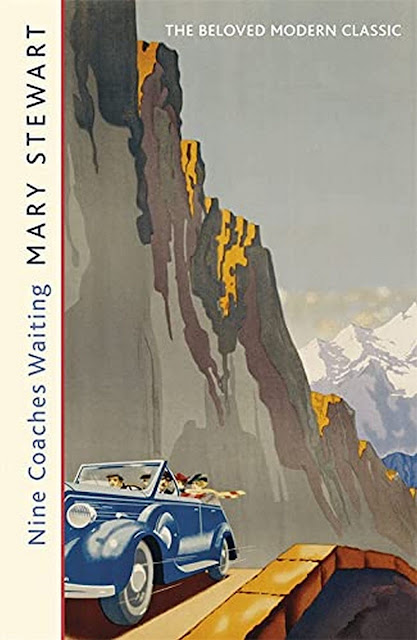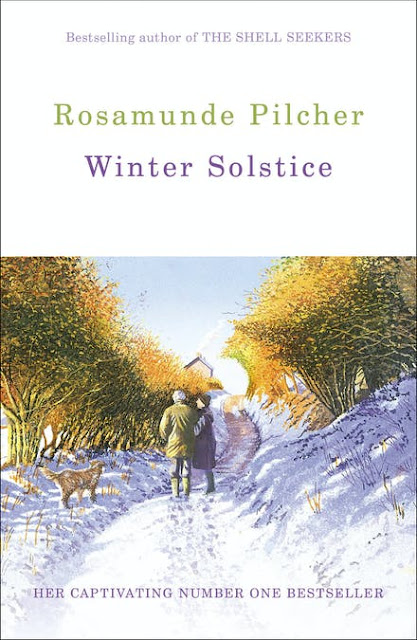20 Books of Summer 2022: Nine Coaches Waiting by Mary Stewart
I love Mary Stewart’s independent, courageous heroines.
Charity Selbourne, who races round Provence in a sports car to beat the villains
in Madam, Will You Talk?, Gianetta Brooke, who climbs up Blaven in the dark to stop yet another murder taking place in Wildfire at Midnight; they are my kind of women.
I had high hopes, then, of Nine Coaches Waiting. Even the title (which apparently comes from Thomas Middleton's The Revenger's Tragedy) sounded
exciting, and the illustration on the cover of the 2011 edition shows a fast
car flying along a precipitous mountain road. The Sunday Telegraph
reviewer apparently called it a ‘zestful romantic adventure (that) grips,
amuses, frightens and delights.’
Unfortunately Nine Coaches Waiting did none of these for me.
Linda Martin grew up in Paris with her English father and French mother, but they died when she was fourteen; after this she lived in an English orphanage. She’s now taken a job as a governess
to nine year old Philippe, Comte de Valmy, who’s inherited the title because
his own parents have also died in an accident.
Linda’s employer is Heloise de
Valmy, wife of Philippe’s uncle Leon. These two live at the spectacular Chateau
Valmy in Haute Savoie, even though it was left to Philippe’s father Etienne, because Etienne and his wife preferred to stay in Paris. Now Philippe normally lives with
the nice third brother, Hippolyte, an unmarried archaeologist, but as he is
away on a dig Philippe has been parked with Leon and Heloise.
Heloise has made it clear that the governess must be English
speaking only, ostensibly so that Philippe is also obliged to speak English and
improve his language skills. Linda’s attempts to remember to speak English, and
also to feign innocence of the content of any French conversations she might
overhear, are an essential part of the book’s plot. And if that sounds
ridiculous, I’m afraid it is no more so than the rest of this nonsensical story.
It soon becomes clear that Stewart is meaning to recreate
the plot of Jane Eyre (Linda even refers to that novel from time to
time). Charlotte Bronte’s most famous work isn’t my favourite classic at the
best of times, but this is a weak and unconvincing attempt to update it. The
one thing that I can say in its favour is that nobody’s locked up in the attic;
though on second thoughts, if they had been Nine Coaches might have benefitted.
On arrival at Valmy Linda meets Leon. He is handsome, charming, fiery, volatile, etc and
also a cripple, owing to a hunting accident some years earlier. He roams the
long corridors in a remarkably fast and silent wheelchair. He is reasonably
polite to Linda, but it’s clear that Philippe is terrified of him. Heloise is a
nervous wreck who goes around in a permanent half-stupor, knocking back
prescription medicines every five minutes and appearing in Philippe’s bedroom
at odd hours of the night.
And then there are the staff, who vary from sweet but dim (Berthe) to evil and
manipulative (Albertine) or just plain evil (Bernard.) Most fortuitously for
us all, the housekeeper Mrs Seddon is English (she and her husband came to
Valmy with Leon’s first wife, who was English and died young.) Just like Jane’s
Mrs Fairfax, Mrs S fills us all in on the complicated family backstory, but
really all you need to know is that Leon thought he was going to inherit the
estate on Etienne’s death, until Etienne inconveniently married late and fathered
little Philippe.
Leon did inherit another estate in the Midi, just in case
you’re tempted to feel sorry for him – but it’s not as flash as Valmy, so he
leaves it in the hands of his son from his first marriage, Raoul. All the income
from the vineyards at Bellevigne is ploughed back into Valmy, so Raoul is constantly struggling
to keep the smaller estate financially afloat.
And just in case you’re wondering, Raoul is also a handsome, charming, reckless, fiery, volatile
womaniser…in fact in many ways a complete chip off the old block. When he turns up at Valmy (having almost
flattened Linda, who apparently thought it a great idea to go for a night time walk
along a narrow bridge on a sharp bend in the fog….) Linda has but one short car
journey with him before;
For better or worse, I was head over ears in love with Raoul de Valmy.
It soon becomes obvious that someone (guess who?) has it in for Philippe; pot-shots are fired, balconies are tampered with, drinks are drugged. Linda is determined to protect him; there is, to be fair, a certain amount of tension introduced, and when she and Philippe have to flee the chateau in the middle of the night and escape the killer by running across open countryside the reader is drawn into their desperation. Stewart, however, dilutes this by having Linda bang on and on and on about who the killer might be, and what on earth she will do if it turns out to be Fiery Raoul. Her heart will be broken. Apparently. A brief mention of this might have been OK, but pages of her weeping and worrying about a man she hardly knows just made me want to shake her.
I have a lot of problems with Raoul, chief among them that Stewart seems to confuse violence with passion. The first time Raoul kisses Linda he actually draws blood, and she is such a nitwit she thinks this is evidence of his love. He frequently calls her ‘you little fool’, he wants his own way at all times, and is clearly (though unfortunately not, of course, clear to Linda) going to turn out exactly like his domineering father.
This idiocy on Linda’s part is compounded by the fact that she also meets a very nice Englishman. William, who is carrying out postgraduate research work on the forestry of a neighbouring estate. William is not fiery, volatile or rich, and he drives around in a knackered old jeep instead of a fast Cadillac; what he is is loyal, kind, thoughtful and sweet. In a few years’ time I bet Linda will look back and realise what a fool she has indeed been.
In Madam, Will You Talk? Stewart gave us wonderful descriptions of Provence; in Wildfire at Midnight she brought the Isle of Skye alive; I could see Loch Scavaig with Blaven brooding above it. In this novel, however, we get little sense of Haute Savoie. There seem to be a lot of trees and mountain roads, and that’s it. Stewart also uses lots of quotes from classical poets, playwrights and authors to illustrate the scenes, but I didn't feel the plot itself was strong enough to support them.
%20-%20wikipedia.jpg) |
| Mary Stewart - image: wikipedia |
If Stewart had not been trying to shoehorn Nine Coaches Waiting into Charlotte Bronte’s framework, I think it could have been a better novel. As it is, however, it is a little more than a rather tedious plod through a predictable plot. Having said that, I know that many readers love this book (though even they have reservations about Raoul), so maybe it just wasn't for me.
Nine Coaches Waiting by Mary Stewart was first published by Hodder and Stoughton in 1958, and republished in paperback by the same publisher in 2011.



Comments
Post a Comment